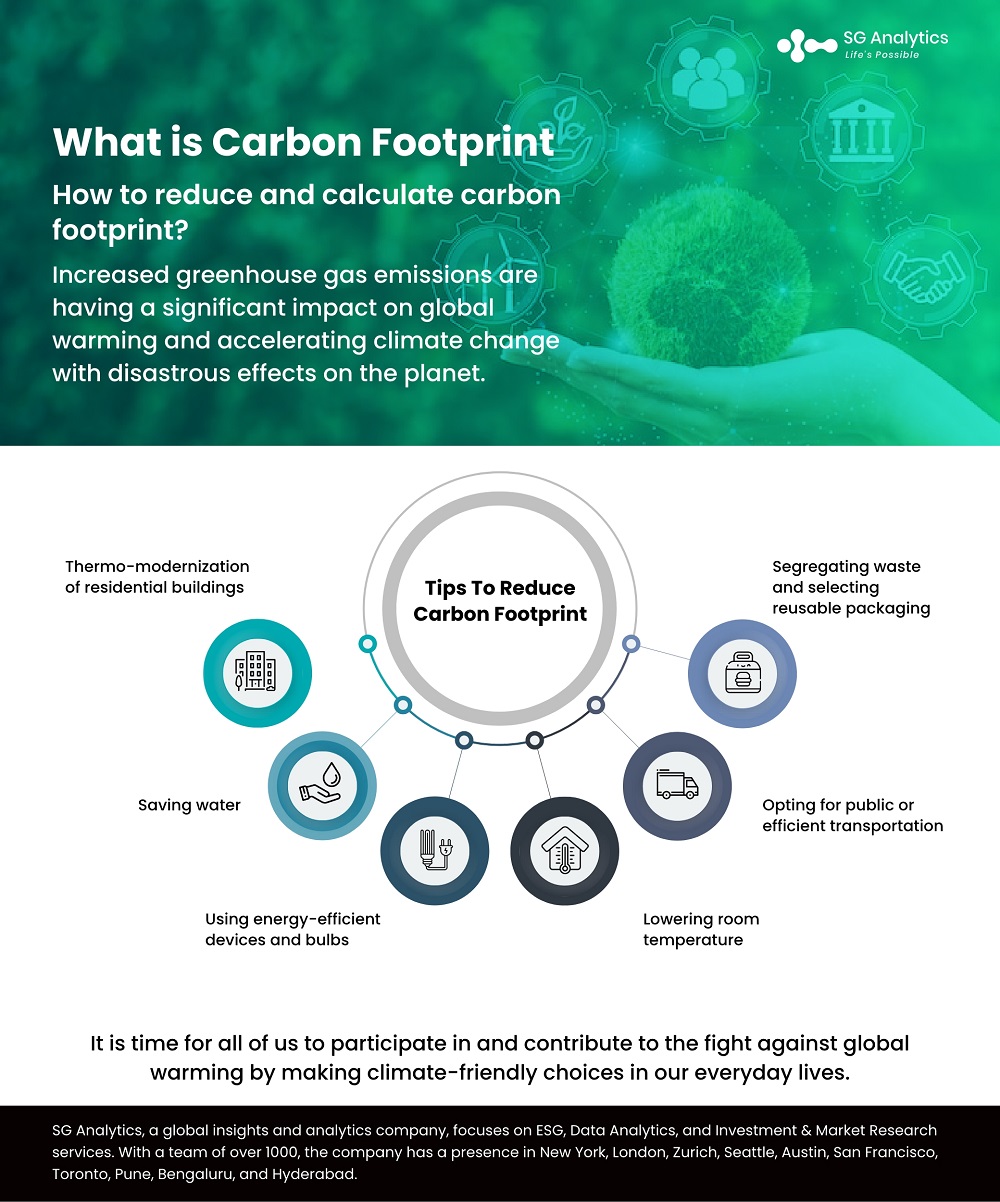Climate change today has become an overwhelming topic of discussion. And when it comes to future impacts, science is complex and filled with unknowns. And to make a difference, real solutions require actions on a global scale. Businesses and individuals need to make choices in their daily lives to lessen the impact on the environment.
Increased greenhouse gas emissions are having a significant impact on global warming as well as accelerating climate change with disastrous effects on the planet. Growing populations are further driving up emissions and depleting the planet’s resources. A recent United Nations prediction highlighted that our population is set to reach 9.7 billion by the year 2050 and over 11 billion by the year 2100.
What is a Carbon Footprint?
Carbon footprint is a concept that represents how individual activities or businesses affect the quality of the Earth’s atmosphere. It expresses an individual's and society's ecological responsibility to contribute to reducing everyday emissions and our carbon footprint.
A carbon footprint accounts for the total amount of greenhouse gas emissions from the production to the end-of-life process for a product or service. The gas emission includes carbon dioxide - the most emitted - and others, such as methane and fluorinated gases, that get trapped in the earth's atmosphere. Transportation, housing, and food generate the bulk of an individual’s carbon footprint.
Read more: What is a Carbon Offset

How To Calculate Carbon Footprint?
All the conversation about carbon emissions and footprints can leave you wondering - what is driving these emissions?
Our everyday actions and lifestyle choices have a significant impact on the environment. And some of the major industries that are creating most of the greenhouse gasses we produce include:
- Energy
- Agriculture
- Land-use change and forestry
- Industrial processes
It therefore becomes critical to understand the generated carbon footprint while also identifying the key areas that can be changed in our lifestyle that further contribute to it. This includes:
- Home energy use and waste production include how much electricity, natural gas, or other fuels are used and where they are sourced from.
- Individual footprints vary depending on the mode of transportation they use. Similarly, the use of public transport and the flights an individual takes also need accounting.
- Another factor is shopping habits and how often you purchase new products like electronics, household goods, and clothing. The lifespan of these items and how they’re produced plays a vital role in carbon emissions.

The connection between greenhouse gas emissions as well as climate change is evident and hard to ignore. And with average global temperatures increasing extreme weather events are becoming more and more severe, leading to a rise in ecological threats resulting from human activity.
Read more: Reducing Food Waste and Carbon Footprint for Food Delivery Services
How to Calculate Your Carbon Footprint?
There are different methods for calculating carbon footprints. While some are industry-specific, others reflect the character of a given industry branch. The most universal and widely used methods for calculating carbon footprint are PAS 2050, designed by the British Standards Institute, and the international standard ISO 14067:2013.
Calculating a carbon footprint mandated a comprehensive approach. Assessing the ecological impact and considering the fuel burned and the emissions will help identify the generated carbon footprint. The calculation also includes a full life cycle, ranging from raw material extraction to disposal.
The analysis of carbon footprint in any industry is carried out by specialized consulting companies. A special online calculator commissioned by the UN is used for household carbon footprints. It takes into account energy consumption, the level of recycling, and the means of transport used by the members of the household.
Personal Carbon Footprint
A personal carbon emission footprint is what we leave behind due to moving about, consuming, eating, and using resources such as energy. A report published by the Environmental NGO - The Nature Conservancy highlighted that every inhabitant on the planet produces an average of four tons of CO2 each year. The report stated that it has now become critical to reduce the carbon footprint to less than two tons per year by 2050. This will further help in ensuring that the temperatures stop rising and do not reach the 2 °C threshold.

Read more: 50% Reduction in Carbon Emissions by 2030 – Sustainable Future With EU Taxonomy
How to Reduce Carbon Footprint
In this decisive fight against climate change, it is vital to incorporate measures to reduce our carbon footprint. Here are some tips that can help:
- Choosing responsible consumption of local products as well as sustainable production
- Opting for sustainable means of transport like public transport, bicycle or on foot, or buying vehicles that are environmentally friendly
- Choosing a 100% renewable energy consumption by investing in energy-saving appliances
- Creating awareness about the importance of reducing the carbon footprint
- Reducing waste by reusing packaging and recycling it.
To reduce the carbon footprint along with its impact on the environment, it is critical to incorporate measures into everyday life to reduce the amount of energy used and make smart choices.
Reducing Carbon Footprint at the Individual Level
The everyday choices of an individual have a large impact on the state of the natural environment. Incorporating measures to reduce the carbon footprint of every household can significantly help in improving air quality. At the same time, stopping some of the negative climate change will become realistic.

Tips To Reduce Carbon Footprint
- thermo-modernization of residential buildings;
- using energy-efficient devices and bulbs;
- segregating waste and selecting reusable packaging;
- saving water;
- lowering room temperature;
- opting for public or efficient transportation.
At the same time, dietary decisions are of equally high importance. Choosing local and seasonal products while decreasing the amount of meat in the diet can also help in reducing greenhouse gas emissions. Reducing an individual’s carbon footprint implies choosing eco-friendly clothing brands. Reducing the use of paper and encouraging the use of recycled sheets or cardboard are equally important. The longer a specific product is used, the better it is for the environment.
Today, the ecological lifestyle is being supported by many. They are ready to make difficult and deliberate choices in order to reduce the amount of greenhouse gas emissions. Due to this, the chances of reducing carbon footprint are on the rise.
Read more: How Carbon Offsetting Can Fight Against Climate Change

Final Thoughts - How to Reduce Carbon Footprint
Carbon footprint indicates the total volume of greenhouse gases generated from everyday economic and human activity. Measured in tons of CO2 emissions, it is important to be aware of the carbon footprint of an activity in order to take measures and devise initiatives to reduce it to the lowest level. In addition, it is equally vital to change day-to-day habits and exercise new rights as a citizen to help the planet. Here are some tips to follow.
- Understanding the science of climate change will equip us to have conversations with family, friends, and local representatives about the issue with confidence.
- Find local climate action groups and organize meetups to stay abreast with ways to help the community.
- Speaking with local representatives and incorporating measures like developing action plans, improving recycling, and adopting green energy policies to reduce carbon footprint.
It is time for all of us to participate in and contribute to the fight against global warming by making climate-friendly choices in our everyday lives.
With a presence in New York, San Francisco, Austin, Seattle, Toronto, London, Zurich, Pune, Bengaluru, and Hyderabad, SG Analytics, a pioneer in Research and Analytics, offers tailor-made services to enterprises worldwide.
As a leading ESG consulting firm in the US, SG Analytics’ ESG data analytics and research solutions are driven by secondary research to analyze ESG trends, metrics, news, and controversies. Contact us today if you are in search of generating deep insights and incorporating ESG (Environmental, Social, and Governance) integration and management solutions to boost your sustainable performance.
About SG Analytics
SG Analytics is an industry-leading global insights and analytics firm providing data-centric research and contextual analytics services to its clients, including Fortune 500 companies, across BFSI, Technology, Media and entertainment, and Healthcare sectors. Established in 2007, SG Analytics is a Great Place to Work® (GPTW) certified company and has a team of over 1100 employees and a presence across the U.S.A., the U.K., Switzerland, Canada, and India.
Apart from being recognized by reputed firms such as Analytics India Magazine, Everest Group, and ISG, SG Analytics has been recently awarded as the top ESG consultancy of the year 2022 and Idea Awards 2023 by Entrepreneur India in the “Best Use of Data” category.









